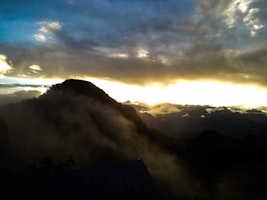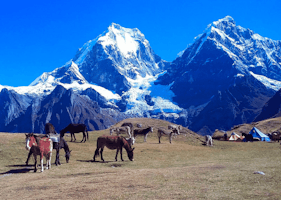Towering above the clouds in the Andes of Peru, Machu Picchu has become more than just an ancient Inca citadel just 80 kilometers outside of Cusco. Discovered in 1911, it has developed into the remarkable archaeological tourist destination we know today, with healthy amounts of adventure and culture adding to its mystique.
Constructed around the year 1450 at 2,430 meters high in the Eastern Cordillera, this symbol of the Incas has some of the most life-changing panoramas in the world. The construction is impeccable; the ashlar of the Temple of the Sun is created with precision, as are much of the buildings. The Intihuatana stones are tailored to fit around the winter solstice sun. The Room of the Three Windows are representative of the different levels of the world: Uku-Pacha, Hanan-Pacha, and Kay-Pacha. The historical significance of Machu Picchu goes even deeper and, when added to the aesthetic wonder of its apex, presents a modern-day miracle in the form of a mountain-top citadel.

The journey to this awe-inspiring site is just as significant. The destination is the same, though there are different paths that can lead you there. For some, the Inca Trail provides the most reasonable option with its classic route, moderate level of difficulty, and trek-friendly facilities. Others may prefer the road less traveled – the Salkantay Trek – with more robust scenery, less traffic, and limitless accommodations.
When it comes to the perfect trip to Machu Picchu, it can mean a completely different experience for each person. Looking at the best and worst aspects of each trail, it is helpful to choose the route that suits your schedule, abilities, and needs. Here are the benefits of the two trails, each with a brief overview. This will help you determine your path up to the glowing wonder of the Peruvian Andes.
The Inca Trail
The classic route to Machu Picchu follows the Inca Trail, which is part of the historic Royal Road within the Incan Empire and is considered one of the best treks in South America and the world. There are many great programs that take advantage of its cultural integrity and the ruins along the route.
Generally, this route takes four days to complete, though some crash courses can get you through it in about two days. Some may keep you on the trail a little longer.

The Salkantay Trek
An alternative route that is gaining steam as a top-tier trail to Machu Picchu is the Salkantay Trek. With fewer travelers and an arsenal of wildlife and flora accompanying every step of the way, programs take advantage of Peru’s natural beauty and charm to find satisfaction in the hike.
The Salkantay Trek requires a little more aptitude to endure its tougher five-day itinerary. It does reward its participants with landscape and terrain that would otherwise go unnoticed, including a loop around Mt. Salkantay and its glaciers. For speed hikers, a four-day trek is possible with the right combination of fitness and determination.
Crowds
Participants on the Inca Trail may not have as many opportunities to see Peru's plants and animals as those on the Salkantay Trek. For better or worse, you will be accompanied by other trekkers heading for the top as this route sees about 180 hikers a day. At the challenging section of the trail – Dead Woman’s Pass – it may be beneficial, but at other moments it may be overwhelming when trying to enjoy the journey. While the facilities may be occupied at an alarming rate, it is noteworthy that there are available facilities.
The Salkantay Trek allows you to enjoy the serenity of solitude while embarking on the journey of a lifetime. When it comes to battling the masses, it will give you room to breathe where the Inca Trail may not. On average, roughly 50 people make their way over the Salkantay Trek per day. Compared to the high number of people taking the Inca Trail daily, it means adventurers have the space to enjoy the trek without worrying about cramped campsites, overflowing foot paths, and the right mindset for a journey down a historic trail. With fewer hikers comes a lack of proper facilities – many travelers along this route bring in-tent latrines and use natural water for bathing and cleansing.

Cost
It can be argued that you get what you pay for, but when it comes to hiking to Machu Picchu, it may not matter all that much to you. The Inca Trail costs nearly twice as much as its counterpart. The price for additional services like better facilities, comfortable accommodations, and established camping, may be higher, but it can be an invaluable asset for your experience. Porters and equipment handlers are available for these trips as another perk of the higher cost.
The Salkantay Trek may not have all the fixings, but it does cover the basics and give you a more straightforward trek. There are possible luxury lodges on the Salkantay Trek, though they are not as common or thrifty as most along this route. The rudimentary camping conditions are the most reasonable accommodations, with mules used for equipment hauling.
Difficulty
Physically speaking, a trek to Machu Picchu is no walk in the park. It requires a sustained fitness level and the mental fortitude to endure the elements and obstacles along the Peruvian wild. The altitude alone is enough to force some travelers to turn back if they haven’t properly acclimatized to the Andes.
Upon closer inspection, however, the Inca Trail is slightly easier than the Salkantay. It is traveled more frequently and is always bustling with trekkers. Over the four-day hike, you will spend six to nine hours a day covering a total of 26 miles (nearly 42 kilometers). You will rise to over 4,200 meters at Dead Woman’s Pass, which is no easy feat.

The Salkantay Trek is much more intense, increasing your distance to 46 miles (over 74 kilometers) in five days. This route also climbs to over 4,500 meters on its way to Machu Picchu, so hiking ability is vital to a successful trip. Not only is it longer, the terrain tends to be steeper, more rugged, colder, and generally poses a greater challenge than the Inca Trail. This can be seen as an exciting challenge for many trekkers who are properly trained for the associated obstacles and have the fitness level to overcome them.
Preparation and Planning
The Inca Trail is so popular that it requires a considerable amount of forethought when planning a trip. There are a limited number of 500 people allowed along the trail each day – and only 200 spots are reserved for tourists (300 spots are reserved for guides, cooks, and porters). During the peak season, from May through August, it may be necessary to purchase your permit at least five or six months ahead of time. Tickets can sell out, and without the necessary planning you may lose your spot on the trip of a lifetime.

The Inca Trail doesn’t bode well for procrastinators. Permits do not allow changes or cancellations. This means you may have to defer your trek for a later date because of a misguided booking or an unforeseen dilemma.
The Salkantay Trek, on the other hand, does not have particular guidelines to follow. Cancellations and changes to itineraries are not difficult to work with and there are no daily limitations. It is relatively easy to find a group or team to hike with. Trips leave for Salkantay nearly every day, so it is a straightforward process of getting onto the trail. Short-notice changes or tours shouldn’t run into too many problems – guides and accommodations can be found even in a tight squeeze.
Scenery
In the Peruvian Andes, everything is beautiful. It only depends on what you are trying to see and experience. The Inca Trail is a world-renowned and classic route. Along the way you will hike through Inca sites like Llactapata, Sayaqmarka, and Phuyupatamarca. It reaches its pinnacle when you pass through the Sun Gate on the morning of your last day. Along with the ruins, the cloud forests and picturesque mountain vistas are truly stunning. It is a classic for a reason and does its best not to leave too much to be desired.

The Salkantay Trek offers a different setting with the same gorgeous aesthetics. Because of its isolated and lengthy approach, coming across the fascinating regional wildlife is a thrilling possibility. Spotting a fox, chinchilla, or even the elusive Speckled Bear in its natural habitat is common. This unique moment is a powerful force on your overall experience, further cementing your hike as the trip of a lifetime.
The landscape is as varied as the fauna, with glaciers, forests, high jungle, and – of course – coffee plantations. It is an all-encompassing journey that molds the identity of the trek and makes Salkantay a rare experience in the best ways possible.
The Inca Trail vs. The Salkantay Trek
At the end of the day, the program that is perfect for you is yours to choose. The classic Inca Trail has helped increase the notoriety of Machu Picchu and the Peruvian Andes. This has helped unearth and spread the cultural significance of the region and its landmarks.
The Salkantay Trek should be recognized as a new and refreshing look at the spectacular terrain of this iconic destination. It covers almost twice the distance and reaches a higher altitude. The trail explores the varied landscape and biodiversity of an incredible wilderness. While it may be basic in its undertaking and not as flashy as the route we have come to love and expect, it provides a captivating take on a world-class wonder.

Whichever route you choose, both will lead you to the evocative city of Machu Picchu, the ultimate prize for a grueling hike!
For anyone in the mood for a different Peruvian adventure, the Ausangate Trail will take you to some of the most remote and enchanting areas of Peru. It can connect to a Machu Picchu trek for an all-encompassing Peruvian adventure. For anyone looking for an immersive experience in the Andes, this is it!







